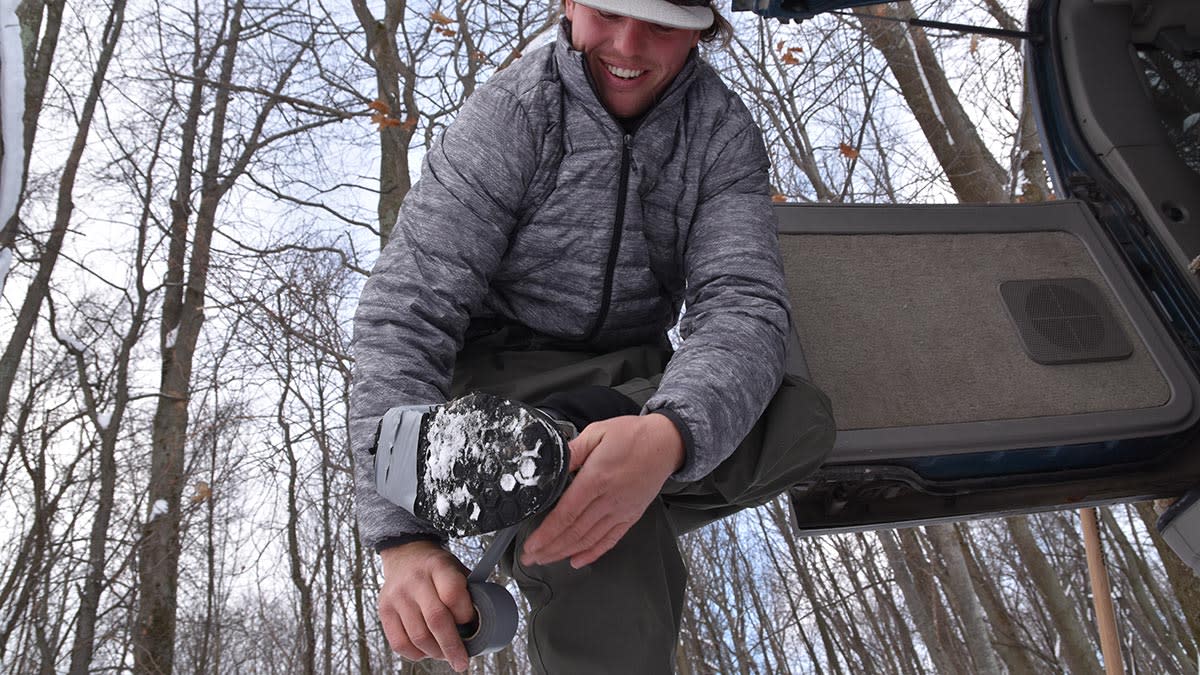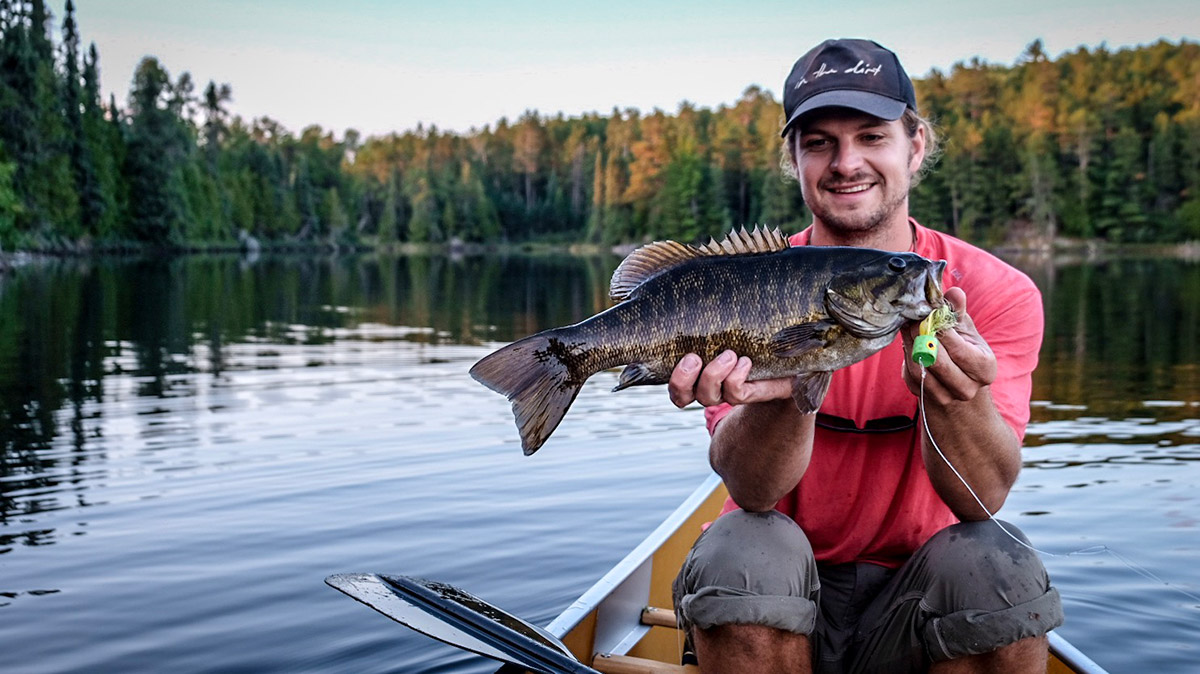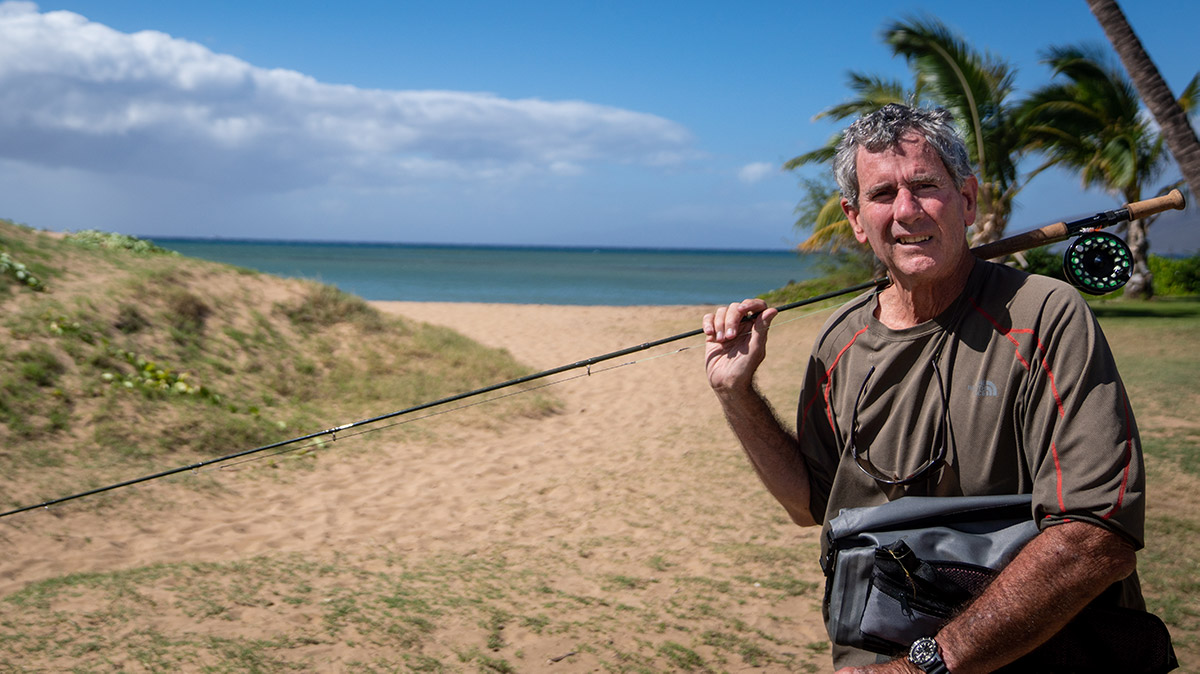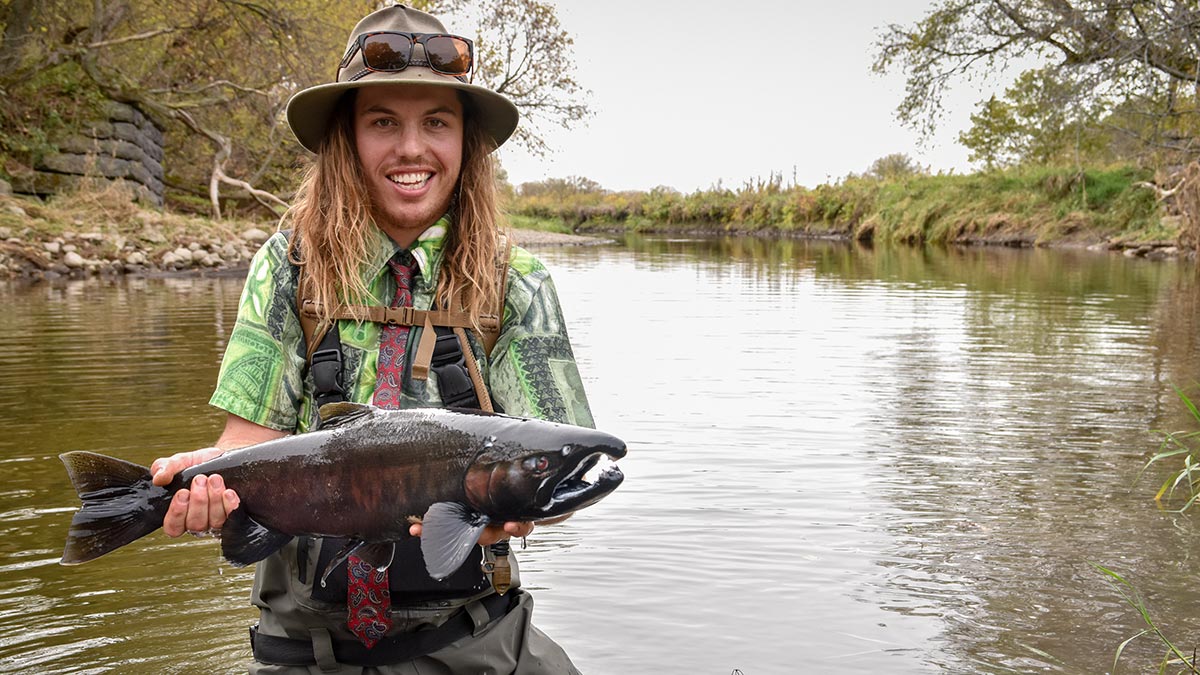
“If you’re too successful to fish whenever you want, one could argue that you’re not really a success.” -John Gierach
John Gierach coined the term “trout bum” in his 1986 book of the same name. He used the phrase to affectionately refer to hardcore anglers who devoted all their time and money to fishing for trout. “A trout bum,” Gierach wrote, “is someone who has made fishing the center of his life. Everything else is secondary.”
While Gierach profiled trout-obsessed fly fishermen, many anglers chasing other species and using different methods embody the same ethos. Fishing bums live out of their vehicle, persist on a diet of ramen noodles and saltine crackers, and often sacrifice personal relationships and careers in favor of chasing fish. Whether it be trout, tarpon, bass, bonefish, or carp, fishing bums have one thing in common—fish come first.
Before we dive into the finer points of fish-bummery, let’s get one thing straight. “Fish bum” is by no means a negative term. Remember in elementary school when the teacher told the class they could grow up to be anything they wanted? And in high school when the guidance counselor told you, “if you follow your passion you’ll never work a day in your life”? That’s what fish bums do. They’re smart, perceptive, and resourceful—they must be to fish so much. Maybe they make less money than they could otherwise, but they do so by choice. For them, fishing isn’t an escape. It’s both the goal and the pursuit. Their days have dorsal fins.
Weston Thier: The Young Gun
When I called Weston Thier to talk about his fish bum philosophy, he was on the Arizona border, making forays into Mexico to fish for native Mexican trout. Wild trout in Mexico? That’s the kind of thing fish bums get keyed into. The stuff you and I have never heard of before.
Thier is an old friend, a classically trained pianist, owner of Fontinalis Fly Fishing, and one of the fishiest people on the planet. I met him while he was working at a Montana fly shop I frequented. We fished together a few times and I’ve been following his piscatorial pursuits ever since.
Thier currently guides for trout, bass, steelhead, and musky in northern Wisconsin. He’s also a commercial fly tyer, specializing in enormous streamers for predatory fish like pike and musky. He forgoes long Wisconsin winters and heads to places like Mexico, Colombia, Argentina, and Chile when it gets cold. He has done more fishing, both in the U.S. and abroad, than most anglers twice his age. His secret? Doing it on the cheap, fish bum style.
“I have a simple standard I use for my fishing trips,” he told me. “If I’m traveling internationally, I allot up to $12 a night to rest my head. If traveling domestic, or whenever my car is available, I simply don’t pay for lodging. You can always sleep in your car, but with the help of friends, public lands, and several handy phone apps, I rarely pay for lodging. Obviously, that means I won’t be fishing Christmas Island or Kamchatka anytime soon, but I’ve wound up fishing some amazing locations without paying more than what breakfast costs in the states.”
Thier relies on apps like OnX Maps to find places to camp, locate boat ramps, and to download maps for areas without phone service, but he also stresses the importance of human connections.
“Using local knowledge to find good fishing, food, and places to sleep is an invaluable practice,” Thier said. “Hitchhiking, staying at hostels, talking with bartenders, and touring the local fish market are my favorite ways to find good local knowledge. The latter is an entertaining place to pick up tips. You can ask fisherman things like, “¿Hola, donde sacaste este róbalo gigante?” (“Where did you catch this big ass snook?!”) Like with all fisherman, their answers should be taken with a grain of salt, but I’ve found that when I explain I’m fishing for sport, they usually open up about the general whereabouts of my target species.”
Thier’s also recommends learning the local language. You don’t have to be fluent. Just making an effort goes a long way. I asked Thier if he had any good stories from his travels and his answer speaks to the point.
“A few years ago, I hitchhiked through Patagonia, which was definitely a struggle with my fledgling Spanish,” he remembered. “At one point, I had no place to stay, so I started hiking towards the river I wanted to fish. The first truck that came by picked me up and the driver happened to be the caretaker of a fly fishing lodge. He let me fish the lodge’s property the next day in exchange for helping him herd sheep. It was one of the best days of my entire trip—swinging streamers for autumn brown trout. He even let me stay in a riverside “refugio,” which had a small wood stove to dry my clothes that had molded from being wet for so long.”
Speaking of moldy clothing, Thier was quick to point out that this way of traveling doesn’t come without challenges.
“As cliché as it sounds, true fish-bumming comes with a litany of compromises, mostly in personal comfort. You will fail. You might have to sleep under a bridge. But I’ve found the reward is usually worth it,” he noted. “If you read about fishing destination locations, you’ll think you need to work overtime to pay for it. In my opinion, that just isn’t the case. Ask strangers for advice, ask farmers permission to fish their land, make friends with the bartender, stick your thumb in the air, fish an unnamed tributary, push your comfort zone. These are all things I do regularly, and I ride the results as far as they’ll take me.”
Terry Baird: The “Original Dirtbag”
Some say young anglers can’t truly qualify as fish bums. They might fish a lot. They might live out of their car. They might travel endlessly. But they haven’t rejected the trappings of a traditional lifestyle, they just haven’t gotten around to considering them yet.
At 74, Terry Baird’s passion for fishing is unparalleled. Talk with him for just a few minutes and you soon realize he is an endless outpouring of ideas about tackle, fish species, and natural history. When I met Baird, one of the first things he said to me was, “I’m not trying to boast or kid you, but I’m an original dirtbag. You should know that if we’re going to fish together.”
Baird’s specialty is Hawaiian bonefish on light fly tackle. He grew up in Hawaii and has lived on nearly every island over the past 60 years. In 1963, he came home from surfing to find his father watching the American Sportsman show. Baird watched as two fly anglers fished Wyoming’s Snake River. He was mesmerized.
“I didn’t know how I was going to do it,” Baird told me, “but I wanted to fly fish in Hawaii.”
Using his knowledge of the ocean from surfing, Baird soon created his own Hawaiian fly fishing culture—a culture of one. Baird is arguably the father of Hawaiian bonefish on the fly. He was honing his bonefish skills in Hawaii long before anyone else was crazy enough to target them with a fly rod. Even today, despite having some of the largest bonefish on the planet, Hawaii remains a relatively obscure location for bonefish because it lacks the large flats typically associated with the species. Fifty years ago, Baird couldn’t find tackle that suited his needs, so he began making his own, splicing together sections of fly line, building rods, and devising his own flies.
Eventually, catching bonefish in Hawaii’s difficult environment wasn’t challenging enough for Baird, and he became obsessed with catching big bonefish on light line. For years he held the 2 pound-test fly caught bonefish record (11 pounds) and is currently working to get it back.
Beyond bonefish, his obsession with big fish on light line has inspired him to travel all over the world in pursuit of records.
“When I first got started, several airlines were competing on price and were offering what they called ‘around the world tickets’ where you paid so much per mile for flexible flights,” Baird recounted. “I worked construction, saving every dollar until I had enough for one of those tickets.”
In the course of his travels, Baird hitchhiked throughout the U.S., Mexico, Canada, Australia, Tasmania, Iceland, New Zealand, and the Bahamas, among others, never having more than a couple hundred dollars in his pocket, and catching several record fish along the way.
“One thing I found out by necessity is you don’t need a bunch of fancy gear,” Baird told me. “I don’t buy into all the marketing bullshit. Most anglers bring way too much stuff. My tackle is incredibly simple. I bring one rod, one reel, and a few lines. One change of clothes is enough for any trip if it is easily washable. I hate hauling along one extra thing.”
Traveling light and keeping things simple is at the heart of Baird’s approach to fishing and travel.
“In a pinch you can tie flies on the cheap,” Baird explained. “I once ran out of flies on Christmas Island, so I tied some coconut fibers to a hook and caught bonefish on them. It’s more about the action than the fly, and you don’t need a lot of flies. My last trip to the Bahamas I brought six flies and only used two of them.”
Baird forgoes fly boxes for resealable plastic bags, he buys his rods and reels used, and he makes his own equipment when he can.
“I always carry a hammock I made from ripstop nylon. It’s light and compact and can be used anywhere. I got stuck in Heidelberg, Germany, once and slept up in the trees for a couple nights. It kept me and my equipment a lot safer than on a park bench,” he said laughing.
Baird also recommends talking to “the gurus” of an area before you visit, the local top anglers.
“I’ve been an IGFA member since high school. Being a member, I can look up other record holders and contact them,” Baird said. “It’s a global network of like-minded people. I can’t tell you how many times I’ve gotten good information or crashed on someone’s couch that I met though IGFA or from calling a local fly shop. You’ve got to be a type-A person and put yourself out there.”
Once Baird is on the ground, he’s a committed hitchhiker and treats it like an art.
“You might be a bum,” he told me, “but you don’t want to look like one. I keep my hair short and try to stay clean shaven. Baby wipes are your best friend for staying clean. You obviously don’t want to smell,” Baird counsels. “Because I travel light, I don’t carry a big pack. I’ve generally just got my fly rod and a small hip pack I made. I just look like a fisherman.”
Baird has a lifetime of hitchhiking experience and is adamant about looking people in the eye and keeping your fly rod visible.
“I’ve hitchhiked around New Zealand four times and never waited longer than 30 minutes to get picked up,” he told me. “My first time in the country I got out of customs, strung up my rod, and took ten steps before someone asked where I was headed. I was like, ‘holy shit, this really works.’”
Even at 74, Baird isn’t slowing down. When I last talked to him he was planning a trip to Pyramid Lake where he hopes to break his own 2-pound-test record Lahontan cutthroat trout of 8 pounds, 9 ounces.
“You don’t need a lot of money to go to these places and have these experiences,” he told me. “I certainly don’t. I’m doing the same things other people pay thousands of dollars for, but for nearly nothing.”
George Rawlinson: The Handy Man
I met George Rawlinson while giving a presentation about carp to a Canadian fly fishing club. When I asked if there were any questions, Rawlinson raised his hand, and in an Australian accent, asked if I’d ever tried rubbing stink-bait on my flies. We were friends immediately.
Rawlinson and I made a point to fish together whenever we could, and it didn’t take long before I realized his strong passion for fishing—freshwater, saltwater, fly, spin, bait—he loved it all. He is a fish bum through and through.
Like Baird, Rawlinson makes his own gear whenever he can. From homemade ice fishing spuds to DIY downriggers, Rawlinson has a knack for piecing together equipment most people would buy.
“You don’t need all the flashy gear,” he told me when I called him. “I’ve made loads of things that saved cash and were actually better than what you would get at a store.”
A carpenter by trade, his skills allow him to solve a common fish bum dilemma. It’s easy to sleep in your vehicle and do things on the cheap when traveling at home, but how can you do the same abroad?
Before a long surfing and fishing trip through Mexico, Rawlinson and a friend bought a 1995 Dodge Ram van (which they nicknamed Ivan) and converted it into a stealth camper in the parking lot of a Home Depot.
“We flew into San Diego, bought the van, and drove it to Home Depot,” Rawlinson recalled. “We bought some tools and timber inside and, over the next 36 hours, lived in the parking lot while we ripped out everything but the front seats and built out the van. We got some crazy looks from other people. The best part was they even let us charge the tool batteries inside. When we were done, we returned all the tools, threw our rods in the van, and headed south.”
Thinking outside the box like this has been a consistent strategy for Rawlinson.
“When we fished Kiribati, we actually booked a surf guide because it was way cheaper,” Rawlinson explained. “We still had a boat man every day, but we’d ask him to take us fishing instead. We caught bonefish, milk fish, giant trevally, and a bunch of other species. The surf guide was happy to oblige because we shared a heap of our catch with him.”
When I asked Rawlinson for his top fish-bum tip, his response was perfect.
“Wet socks aren’t that bad. It’s better to fish in leaky waders than not fish at all.”
I’m guessing that’s some sort of metaphor for fish bumming, but I’ll let you make the call.








